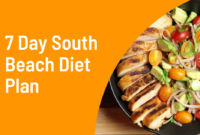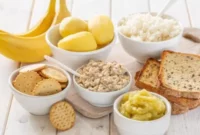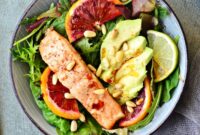What is the South Beach Diet Phase 1? This initial phase is a crucial component of the overall South Beach Diet plan, focusing on rapid weight loss through strategic carbohydrate restriction. It emphasizes the consumption of healthy fats and lean proteins, while strictly limiting less healthy carbohydrates, particularly those with a high glycemic index. Understanding the principles, permitted foods, and potential challenges of Phase 1 is key to successfully navigating this initial, yet vital, stage of the diet.
Phase 1 typically lasts for two weeks and aims to jumpstart weight loss by reducing insulin levels and promoting fat burning. This involves eliminating many processed foods, sugary drinks, and refined carbohydrates. The diet allows for a wide variety of healthy choices, including lean meats, fish, poultry, non-starchy vegetables, and healthy fats like olive oil and avocados. While this initial restriction can be challenging, the potential benefits – both short-term and long-term – often make it worthwhile for those seeking a healthy approach to weight management.
Health Implications and Considerations
The South Beach Diet Phase 1, characterized by its strict limitations on carbohydrates and its emphasis on healthy fats and lean proteins, can produce noticeable short-term effects, but also presents potential long-term considerations. Understanding these implications is crucial for making informed decisions about its suitability.
Short-term effects often include rapid weight loss due to the significant reduction in carbohydrate intake and subsequent water loss. Many individuals also report increased energy levels, improved blood sugar control, and reduced bloating. However, these benefits should be viewed within the context of the diet’s restrictive nature and potential drawbacks.
Potential Short-Term Effects of Phase 1
The initial rapid weight loss experienced during Phase 1 is primarily due to water loss, as carbohydrates store water in the body. While this can be motivating, it’s important to remember that this isn’t solely fat loss. Increased energy levels are often attributed to stabilized blood sugar levels, as the diet minimizes the blood sugar spikes and crashes associated with high-carbohydrate meals. Some individuals may experience reduced bloating due to the restriction of certain carbohydrates known to cause gas and digestive discomfort. However, it’s important to note that these benefits are typically temporary and can vary greatly between individuals.
Potential Long-Term Effects of Phase 1
Sustaining Phase 1 indefinitely poses potential risks. The highly restrictive nature can lead to nutrient deficiencies if not carefully managed. Long-term adherence may increase the risk of developing nutrient deficiencies, particularly of fiber, certain vitamins (like B vitamins and vitamin C), and minerals. Metabolic changes, while initially beneficial for some, could become problematic if the diet is not transitioned to a more balanced approach. The long-term effects are largely dependent on individual adherence, nutritional supplementation, and the transition to subsequent phases of the diet.
Individuals Who Should Avoid or Modify Phase 1
Certain individuals should exercise caution or avoid Phase 1 altogether. People with pre-existing kidney disease, for example, may need to modify the diet due to its high protein content, which can strain the kidneys. Individuals with diabetes should consult their physician before starting any restrictive diet, as it could lead to complications if not properly managed. Those with a history of eating disorders should also approach this diet with extreme caution, and ideally under the guidance of a registered dietitian or therapist.
Comparison with Other Low-Carbohydrate Diets
The South Beach Diet Phase 1 shares similarities with other low-carbohydrate diets like the Atkins diet and the ketogenic diet, but also possesses unique characteristics. Understanding these similarities and differences is crucial for choosing the right approach.
- Similarities: All three diets restrict carbohydrate intake, leading to weight loss through ketosis (in the case of Atkins and Keto) or reduced calorie intake. They all emphasize protein and healthy fats.
- Differences: The South Beach Diet, unlike Atkins, allows for the inclusion of certain healthy carbohydrates, like whole grains, in later phases. It also focuses more on healthy fats and portion control than the ketogenic diet’s strict emphasis on high fat intake. The South Beach Diet is often considered less restrictive than the Atkins diet in the long term.
Illustrative Examples
To better understand the South Beach Diet Phase 1, let’s examine sample meals and a typical day’s experience. These examples illustrate the focus on lean protein, healthy fats, and non-starchy vegetables. Remember, portion sizes should be adjusted to meet individual caloric needs.
Sample Meals for South Beach Diet Phase 1
This section details a breakfast, lunch, and dinner suitable for the restrictive first phase of the South Beach Diet. Note the emphasis on unprocessed foods and the avoidance of sugary items and refined carbohydrates.
Breakfast: A fluffy omelet featuring two eggs scrambled with a handful of chopped spinach, a tablespoon of crumbled feta cheese, and a sprinkle of black pepper. The texture is light and airy, the taste subtly savory with a hint of salty feta, and the aroma is mildly eggy and herbaceous.
Lunch: A large salad composed of mixed greens, grilled chicken breast (approximately 4 ounces), sliced avocado, cherry tomatoes, and a light vinaigrette dressing made with olive oil, lemon juice, and herbs. The salad offers a refreshing crunch from the greens and tomatoes, the creamy richness of the avocado, and the lean protein of the chicken. The aroma is fresh and slightly tangy.
Dinner: Baked salmon (approximately 6 ounces) seasoned with dill and lemon, served alongside a side of steamed asparagus and a small portion of quinoa. The salmon offers a flaky texture and a rich, slightly oily taste. The asparagus provides a tender-crisp bite and a delicate, slightly grassy flavor. The quinoa adds a nutty, slightly earthy note. The overall aroma is savory and subtly fishy.
A Typical Day on the South Beach Diet Phase 1
This narrative describes a typical day, highlighting the sensory experiences encountered while adhering to the diet’s initial phase. The emphasis is on the feelings of fullness and satisfaction derived from nutrient-rich, unprocessed foods.
The day begins with the aforementioned omelet. The warmth of the eggs, the subtle saltiness of the feta, and the slight bitterness of the spinach combine for a satisfying and energizing start. The aroma fills the kitchen, creating a pleasant morning experience. Feeling full and energized, I tackle my morning tasks.
Lunch brings the refreshing salad. The satisfying crunch, the creamy avocado, and the lean protein of the chicken provide a balanced and filling meal. The light vinaigrette adds a bright, zesty flavor that prevents the meal from feeling heavy. I feel a sense of lightness and renewed energy.
Dinner brings the baked salmon, asparagus, and quinoa. The rich, oily texture of the salmon contrasts beautifully with the crisp asparagus and nutty quinoa. The satisfying flavors and aromas leave me feeling content and satiated. The meal provides a feeling of comfort and fullness without heaviness. I feel satisfied and ready for a restful night’s sleep. The overall experience throughout the day is one of sustained energy and comfortable fullness, without the cravings or energy crashes often associated with restrictive diets.
Epilogue
Successfully completing South Beach Diet Phase 1 lays a strong foundation for long-term weight management and improved health. While the initial restrictions might seem daunting, understanding the rationale behind them and implementing effective strategies for meal planning and managing cravings will significantly increase the chances of success. Remember to consult your physician before starting any new diet, particularly if you have pre-existing health conditions. The initial weight loss and improved energy levels often experienced during this phase serve as strong motivation to continue on the path to a healthier lifestyle.




